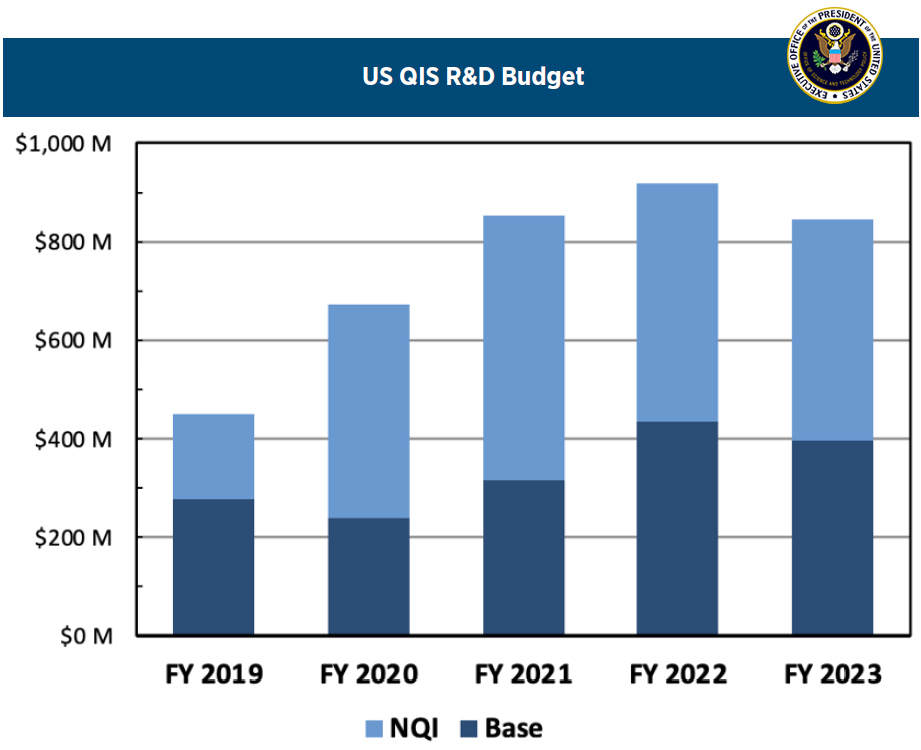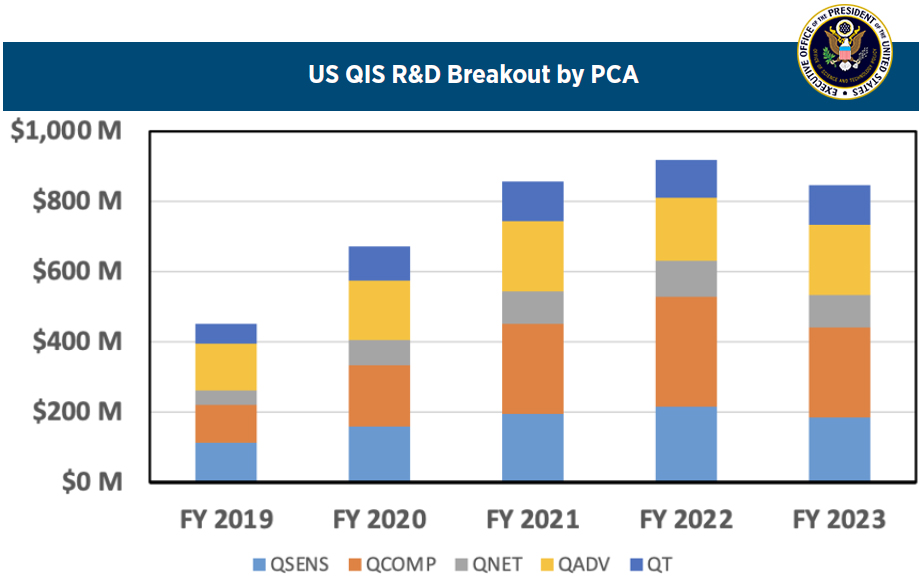January 27, 2023
More Money, More Guidance for Quantum Information Science R&D


The Pentagon wants a qualitatively superior force – one that can sense, analyze data collected by sensors, and target opponents more rapidly and precisely. Quantum Information Science is part of how it plans to create that force.
Over the past several months, both the White House and Congress have taken steps to advance Quantum Information Science R&D and reduce related cybersecurity risks.
WHAT IS QIS?
Quantum information science (QIS) combines the principles of quantum mechanics with information theory and technology to advance the development of novel and transformative computers, sensors, networks, and encryption. QIS will transform the collection, generation, processing, and communication of information. According to the Defense Science Board, QIS will provide DOD substantial computation power for cryptography, signal processing, modeling and simulation, artificial intelligence/machine learning, and advanced sensors with “stunning resolution.”
PRIORITIES
Federal R&D efforts for QIS are outlined within the National Strategic Overview for Quantum Information Science and focus on six areas: science, workforce, industry, infrastructure, security, and international cooperation. This analysis provides examples of recent actions taken since the passage of the National Quantum Initiative in December 2018.
HIGHLIGHTS FROM FISCAL YEAR 2023 AUTHORIZATION AND APPROPRIATIONS BILLS
The recently passed FY23 NDAA advanced R&D efforts to advance “new capabilities necessary for long-term strategic competition with China and Russia.” This included several QIS R&D policy provisions:
Section 233 – Plan for Investments to Support the Development of Novel Processing Approaches for Defense Applications. Directs the Secretary of Defense to submit a plan that outlines “novel processing approaches” such as utility scale quantum computing, exascale computing, and other emerging techniques in computation including associated algorithm and hardware development.
Section 835 – Curricula on Software Acquisitions and Cybersecurity Software or Hardware Acquisitions for Covered Individuals. Directs the president of Defense Acquisition University to supplement existing training curricula to include, “quantum technologies,” and submit a plan identifying, “resources required and costs associated with such implementation.”
Section 861 – Strategy for Increasing Competitive Opportunities for Certain Critical Technologies. Directs the Secretary of Defense to submit a strategy to increase competitive opportunities for U.S. companies to transition critical technologies into major weapon systems and programs of record, “to enhance the integrity and diversity of the defense industrial base.” Quantum science technologies are defined as a “critical technology” and directed to be included.
Section 5913 – National Research and Development Strategy for Distributed Ledger Technology. Directs Office of Science and Technology Policy to submit an interagency strategy for distributed ledger technologies R&D and applications.
Comptroller General Assessment of University Scholarships to Support Future Defense Quantum Information Science Workforce Needs. Directs GAO to review DOD university programs supporting quantum information science, to examine workforce needs for quantum information science over the next 10 years, and assess inclusion of QIS within current STEM programs.


Chart I. Note: “Base” is baseline QIS R&D activities Source: NQI 2023 report
The Fiscal Year 2023 Consolidated Appropriations Act fully funded QIS programs across the government including, DOD, the Department of Commerce, NASA, National Institute of Standards and Technology (NIST), the National Science Foundation (NSF), the Department of Health and Human Services, and the Department of Energy.
DOE received a total of $245 million, including $125 million for five of the DOE-led National Quantum Information Science Research Centers. DOE was also directed to continue coordination efforts with, the National Science Foundation other federal agencies, and “private sector stakeholders, and the user community”,” and to provide a “report of near-term application developments and of the research funding breakdown” across the five centers.”
The National Institutes of Health’s Office of Data Science received $85 million, with a mandate to implement a new pilot program with DOE to study the potential for quantum computing in biomedical sciences. The NSF was funded at $235 million to continue QIS R&D, including $50 million for research at NQIS Research Centers. This was approximately $55 million less than the requested.
NIST funding for QIS reached $54 million, with a modest $3.5 million program increase for university-based research programs. eNIST was encouraged to further the development of quantum-resistant cryptography and standards; no additional appropriations were provided for this mandate.
DOD saw several FY23 Consolidated Appropriations program increases, most notably:
- $30 million for USAF Ion Trap Quantum Computing
- $10 million for USAF Quantum Network Testbed
- $5 million for USAF Secure Quantum Computing Facility
- $30 million for university-based quantum materials applied research
- $10 million for Army quantum technologies for armament systems
- $1.4 million for Army quantum computing technologies
RELEASE OF THE “NATIONAL QUANTUM INITIATIVE SUPPLEMENTAL TO THE PRESIDENT’S FY 2023 BUDGET”
On January 6, 2023, the White House released the National Quantum Initiative Supplemental to the President’s Fiscal Year 2023 Budget, as reported and compiled by the Subcommittee on Quantum Information Science of the National Science and Technology Council (NSTC).
Similar to the broader NSTC budget supplemental, the NQI supplemental is a technical requirement and analytical report, not a request for additional or “supplemental” funds to the President’s Fiscal Year 2023 budget request.
The FY23 report includes a detailed itemization of major QIS R&D activities by agency. It provides an overview of actual budget expenditures for QIS R&D from Fiscal Years 2019-2023. The totals in Chart I are: FY19 – $449 million; FY20 – $672 million; FY21 – $855 million; FY22 – $918 million; and FY23 –$844 million requested.


Chart II. Source: NQI 2023 report
Distributions are further broken down into five NQI Program Component Areas:
- Quantum Sensing and Metrology (QSENS). The use of quantum mechanics to enhance sensors and measurement
- Quantum Computing (QCOMP). Includes development of quantum bits (qubits) and entangling gates, quantum algorithms and software, digital and analog quantum simulators using programmable quantum devices, quantum computers and prototypes, hybrid digital-analog computing, and quantum-classical computing systems.
- Quantum Networking (QNET). Includes creation and use entangled quantum states, distributed over distances and shared by multiple parties, for new information technology applications and fundamental science.
- QIS for Advancing Fundamental Science (QADV). Includes foundational efforts to invoke quantum devices and QIS theory to expand fundamental knowledge in other disciplines
- Quantum Technology (QT). Includes work with end-users to deploy quantum technologies in the field and develop use cases, basic R&D on supporting technologies for QIS engineering, and efforts to understand and mitigate risks raised by quantum technologies
The recent growth in QIS R&D is driven in part by NQI activities such as the establishment of quantum consortia by NIST, Quantum Leap Challenge Institutes (QLCIs) by NSF, and National QIS Research Centers by DOE.
Two recent documents signed by the White House show the priority placed on QIS: the May 2022, Executive Order to Enhance the National Quantum Initiative Advisory Committee elevated the committee to report directly to the President’s Office of Science and Technology Policy, and increased its membership. The May 2022 “National Security Memorandum 10 Promoting United States Leadership in Quantum Computing While Mitigating Risks to Vulnerable Cryptographic Systems,” directs agencies and OMB to begin the multi-year process of migrating vulnerable computer systems to quantum-resistant cryptography. Migration is to be completed, “as much as feasible, by 2035.”
NSM 10 in essence creates a new cybersecurity requirement for Federal agencies, and according to CRS, “reflects a significant shift in how agencies design, build, and operate their networks.
QUANTUM COMPUTING AND CYBERSECURITY THREATS
President Biden signed the Quantum Computing Cybersecurity Preparedness Act into law January 3. The act highlights the threat of adversarial nation-state quantum computing advances that could break today’s most advanced encryption standards. A Cryptographical Relevant Quantum Computer (CRQC) will be capable of breaking most public-key cryptography used on digital systems, putting at risk our national and economic security. This risk exists now. Today, adversaries are exfiltrating encrypted data that they will decrypt later when a CRQC is developed, so-called “Store Now, Decrypt Later” attacks.
The act directs OMB, the National Cyber Director of the White House, and DHS’s Cybersecurity and Information Security Agency (CISA) to issue guidance for federal agencies to migrate to quantum-resistant cryptography ahead of this risk. The act directs prioritization of applications, hardware, and software that can easily be updated with quantum-resistant cryptography. This is the first stand-alone policy legislation designed to address these risks and codifies NIST’s ongoing work to standardize post- quantum cryptography or quantum-resistant encryption algorithms and digital signatures, and OMB’s recent guidance for all Federal agencies to inventory vulnerabilities and plan for migration to quantum-resistant cryptography. National security systems are exempt from the legislation per National Security Directive 42.
WHAT’S NEXT
We expect the Biden Administration to release the FY24 Presidential Budget in March. With a divided Congress we don’t expect completion by the start of the year. The 118th Congress will also have to deal with re-authorizing major portions of the National Quantum Initiative of 2018.
The outlook for QIS R&D funding is promising. Support from Congress has been bipartisan and White House leadership via the National Quantum Coordination Office is strong.
Quantum-resistant cryptography and related cybersecurity implementation strategies for federal agencies are less clear as they attempt to implement NSM 10 and identify and mitigate cryptographic vulnerabilities ahead of 2025 and 2035 deadlines in what may be a disruptive budgetary environment—particularly for civilian agencies. Over the next decade, significant and sustained funding will be needed to modernize and ensure cryptographic agility via deployment of quantum-resistant solutions across Federal IT systems most importantly for high-value and high-impact systems.